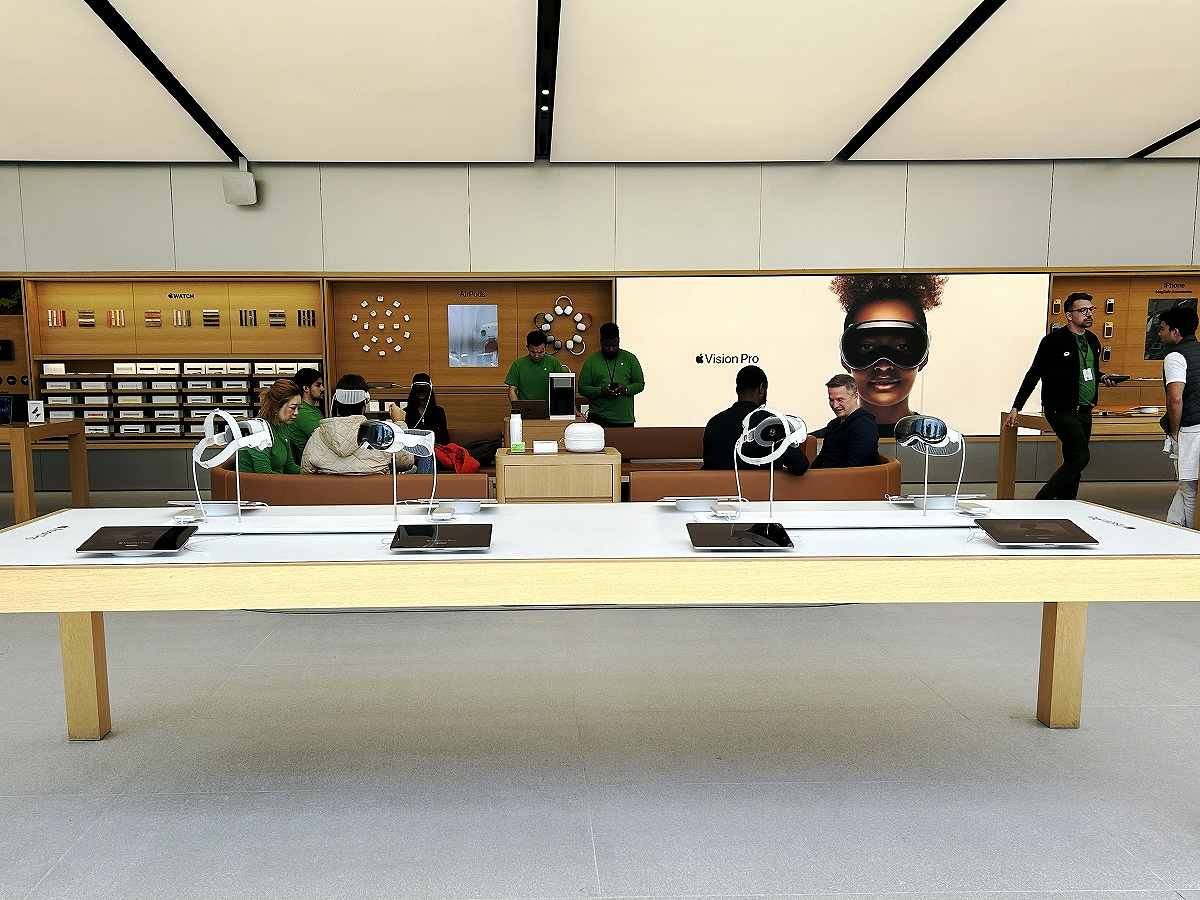
Apple’s flagship retail store in Union Square in San Francisco.
12:41 JST, May 3, 2024
SAN FRANCISCO – Lines used to stretch around the block at Apple’s flagship Union Square retail store and others around the world, with hordes of eager customers camping out for days, just to be among the first to lay hands on its newest products. A decade ago, the Apple hype was seemingly unstoppable as the company unveiled a steady stream of must-have gadgets.
Today, however, Apple – long thought of as the world’s most innovative and valuable company – is at a crossroads.
As the Cupertino, Calif.-based company struggles to revive consumer enthusiasm for its products of the past decade, Apple reported its biggest quarterly revenue decline in more than a year. The company’s sales for the quarter ended March 30 fell 4 percent from a year earlier, to $90.75 billion, while net income fell 2 percent, to $23.64 billion.
Over the past few months, the company has also been unable to capture a mainstream audience with its expensive Vision Pro headset and finally abandoned its years-long attempt to develop a self-driving car. Meanwhile, consumers overseas – especially in China – are increasingly turning to smartphones from Huawei Technologies and Samsung, while existing customers happily hang onto the Apple products they have.
“We have hundreds of millions of products out there in use that are five years old or greater,” said John Ternus, Apple’s senior vice president of hardware engineering, in an interview with The Washington Post in April. “And that number just keeps getting bigger.”
To reverse this slump, Apple Chief Executive Tim Cook is expected to hint at new artificial intelligence features next week and unveil them at the company’s World Wide Developers Conference in June. Analysts are pinning hopes that Apple will finally capitalize on the AI boom and unveil new, must-have features in the upcoming iPhone to re-energize customers and drive demand. The stakes are high for Apple, which made history last year by hitting a market capitalization of more than $3 trillion, fueled in part by demand from emerging markets – such as India – and excitement over the company’s then-unreleased headset.
But earlier this year, Apple was dethroned as the most valuable company in the world to Microsoft, which became one of those powerful leaders in the AI boom through its investment in ChatGPT maker OpenAI. And last month, Apple laid off more than 600 employees after shuttering its self-driving car project, its largest workforce reduction in years.
Meanwhile, in the backdrop, the company is also facing increased scrutiny from regulators in the European Union, it’s No. 2 market by revenue, and an antitrust lawsuit from the U.S. Justice Department, which alleges that Apple is abusing its market power.
“Where’s the next big thing?” said Bob O’Donnell, founder and chief analyst at TECHnalysis Research. “Apple always seems to pull a rabbit out the magic hat every time, but it just feels like the options for doing so are getting smaller and smaller.”
Apple did not respond to a request for comment.
Apple’s crown jewel of its product lineup remains the iPhone, and there’s little to suggest that will change soon. But even Apple’s most popular product, which generated more than $200.6 billion in revenue for the company during its 2023 fiscal year which ended Sept. 30, is not immune to shifting tastes.
The proof is in the numbers: On Thursday, Apple reported quarterly iPhone sales of $45.9 billion, down more than 10 percent from a year earlier.
Part of this dip can be attributed to Apple’s overseas performance, where the iPhone enjoys less of a stranglehold on consumer preference than it does in the United States.
The company’s Greater China region, which encompasses mainland China, Hong Kong, Macao and Taiwan, has long been one of Apple’s most crucial growth zones. But growing pressure from a handful local rivals – including Shenzhen-based Huawei, which surmounted U.S. sanctions aimed at slowing its advance in late 2023 by producing a smartphone with a domestically made processor – cut sharply into Apple’s market share in the region earlier this year.
Data from market research firm Counterpoint Research indicated that Apple’s sales in China dipped by nearly 20 percent in the first quarter of 2024, a shift that senior research analyst Ivan Lam attributed partially to “Huawei’s comeback.”
The full scope of the company’s decline in China became clear Thursday, when Apple reported an 8 percent revenue dip compared to a year earlier.
For years, iPhones were a status symbol in China, but geopolitical tensions have soured some consumers on U.S. brands. The rise of Chinese smartphone brands was cheered recently by patriotic shoppers in China, with the news becoming a trending topic on the Chinese social media platform Weibo.
“I’ve switched from the fruit to Huawei, and I don’t regret it,” one Chinese shopper wrote on Weibo, using a nickname for Apple. “Huawei is really nice to use. I won’t ever buy the fruit one out of vanity anymore. Go Huawei! Go domestic products!”
The iPhone may soon “return to growth again in China,” said Wedbush Securities analyst Daniel Ives, owing to “a pent-up demand cycle with an AI-driven iPhone 16 model on the horizon.” But Apple’s stature in China could also be affected by geopolitical factors, including potential retaliation from Beijing if TikTok is forced to shut down in the United States after Congress recently passed legislation.
Apple is also facing regulatory challenges that could force it to rethink designs of existing and future products and services.
Some of Apple’s popular smartwatch models, two of which were temporarily banned at the end of 2023, also face an uncertain future. New Apple Watch Series 9 and Watch Ultra 2 devices sold in the United States tell their owners that a built-in blood oxygen monitoring app is “no longer available” when they attempt to use it, owing to a patent infringement dispute with the medical technology company Masimo. That legal back-and-forth is ongoing, and a trial may not take place until 2025.
The E.U. this year unveiled a landmark anti-monopoly law, the Digital Markets Act, that forced the company to allow third-party app stores on iPhones for the first time. Apple generated about $85 billion in annual revenue from its services business, which includes the App Store, where it gets fees for app purchases.
Apple has tried to retain control over its platform in the E.U. by asserting it will charge fees for app purchases through third-party app stores, in a move that infuriated some app developers and also riled E.U. officials. Just weeks after the DMA came into effect, the European Commission announced it had opened an antitrust probe into Apple, with the company facing fines of up to 10 percent of its global revenue.
Apple said at the time that it was confident it was complying with the DMA.
Then, in March, the Justice Department launched an anti-monopoly probe against Apple. Prosecutors have accused Apple of abusing its market power to keep app developers and consumers in its ecosystem – similar allegations to the ones being investigated in the E.U. If the court finds in prosecutors’ favor, it could order changes in Apple’s business structure.
“We allege that Apple has maintained monopoly power in the smartphone market, not simply by staying ahead of the competition on the merits, but by violating federal antitrust law,” Attorney General Merrick Garland said in a statement. “If left unchallenged, Apple will only continue to strengthen its smartphone monopoly.”
Apple spokesman Fred Sainz said at the time that the lawsuit is “wrong on the facts and the law” and that the company “will vigorously defend against it.”
Meanwhile, Apple’s attempts to grow beyond its handful of core products have had found limited success. The company’s Vision Pro headset was released this year to mixed reviews. Critics have acknowledged the sophistication of Apple’s hardware, but they lamented its limited feature set and app ecosystem.
Since then, the nearly $3,500 headset has struggled to find consumers outside mixed-reality and Apple fan communities. And while the product has been available only for the past few months, many are skeptical that it will become mainstream anytime soon.
“I don’t think there’s any hope that this will be the next big thing,” said O’Donnell, the TECHnalysis Research analyst. “It’s way too expensive, and the value you get for the vast majority of people is short-lived.”
Then, shortly after the Vision Pro’s launch, Apple pulled the plug on one of its most ambitious projects: building a self-driving car.
For nearly a decade, rumors swirled about Apple and its highly secretive self-driving car project, dubbed “Project Titan.” Although the company was far behind its competitors – including Tesla, Waymo and Cruise, which had deployed vehicles to the public in California and other markets across the United States – industry observers regarded Apple’s push into self-driving technology as a vote of confidence in the potential of automated driving. It also gave investors hope of a new cornerstone technology from the company.
Apple never publicly acknowledged the project, but there were signs last year that it was quietly testing: Public data from the California DMV showed it tested 67 cars over 450,000 miles in California between December 2022 and November 2023, more than threefold increase from the year before. Meanwhile, its gold SUVs – outfitted with large, boxy sensors – could be seen around Apple’s headquarters in Cupertino.
But then, in February, the project officially unraveled: The company scrapped the project, closing a long chapter of speculation on what the company was planning to do with the cars. Instead, Apple turned its focus to generative AI projects, giving industry observers hope that the Apple is finally ready to join the AI hype cycle.
“We continue to feel very bullish about our opportunity in generative AI,” Cook said on a conference call with investors, adding Apple is making “significant investments” that it plans to share with customers soon.
“We believe in the transformative power and promise of AI and we believe we have advantages that will differentiate us in this new era,” Cook said.
For now, though, the shape of the company’s AI ambitions remain unclear. And Apple is late to the party while rivals Microsoft, Amazon and Meta spend billions of dollars to support AI infrastructure. Apple’s first wave of devices that emphasize AI could debut as early next week, when the company is expected to unveil a long-awaited slate of new iPads.
Not everyone is giving up hope. Carolina Milanesi, Creative Strategies’ president and principal analyst, said despite the grim earnings outlook for the near future, Apple “always seems to wiggle their way out of these situations.”
“The fact that they have so many different revenue streams is what allows them to not feel the pressure in the same way as a one-trick pony would,” she said.
"News Services" POPULAR ARTICLE
-

American Playwright Jeremy O. Harris Arrested in Japan on Alleged Drug Smuggling
-

Japan’s Nikkei Stock Average as JGB Yields, Yen Rise on Rate-Hike Bets
-

Japan’s Nikkei Stock Average Licks Wounds after Selloff Sparked by BOJ Hike Bets (UPDATE 1)
-

Japan’s Nikkei Stock Average Buoyed by Stable Yen; SoftBank’s Slide Caps Gains (UPDATE 1)
-

Japanese Bond Yields Zoom, Stocks Slide as Rate Hike Looms
JN ACCESS RANKING
-

Tokyo Economic Security Forum to Hold Inaugural Meeting Amid Tense Global Environment
-

Keidanren Chairman Yoshinobu Tsutsui Visits Kashiwazaki-Kariwa Nuclear Power Plant; Inspects New Emergency Safety System
-

Imports of Rare Earths from China Facing Delays, May Be Caused by Deterioration of Japan-China Relations
-

University of Tokyo Professor Discusses Japanese Economic Security in Interview Ahead of Forum
-

Japan Pulls out of Vietnam Nuclear Project, Complicating Hanoi’s Power Plans
























